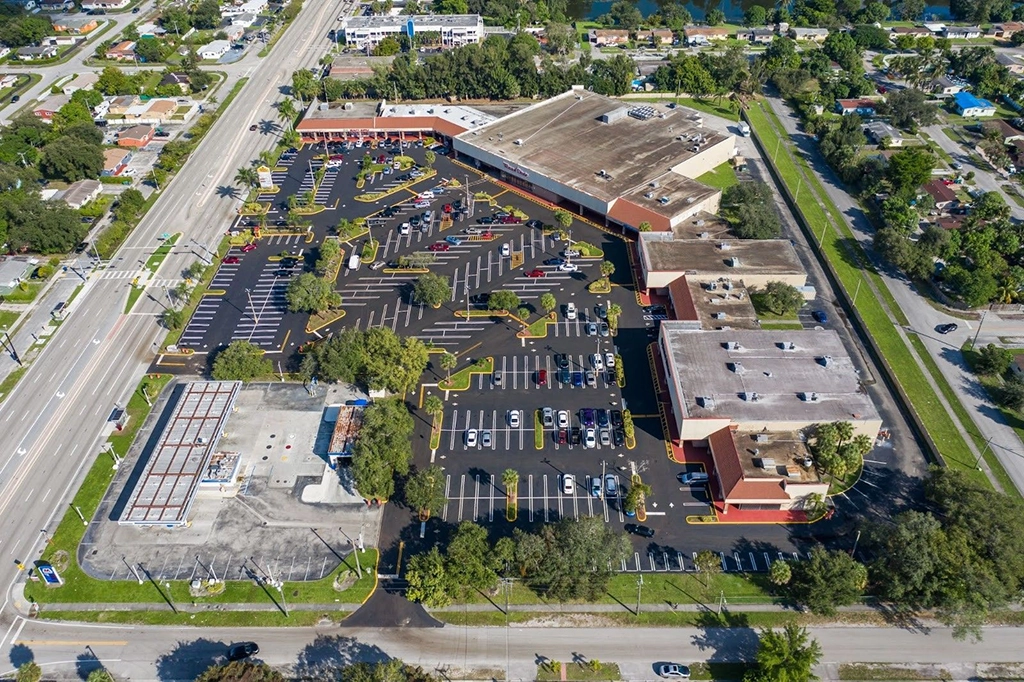No surprise, southern Florida sees over 54 inches of rain every year (that is a lot of water!), as well as intense humidity.
As harmless as water may seem, many commercial property owners overlook the impact of water on asphalt parking surfaces.
So how exactly will rain damage your new asphalt?
Well, big rainfalls and standing water erode asphalt by forcing apart the bonds between the asphalt binder and the rocks and sand. This weakens the asphalt surface causing cracks, potholes and possibly sinkholes. Humid air can also settle into cracks creating air gaps just waiting for water to settle in. All of this causes pre-existing cracks to expand and new cracks to form. Every rain, allows a rinse, wash and repeat of this damaging cycle.
Think of the Grand Canyon. This wondrous space and many of its valleys get deeper and wider every year because of the erosive flow of water from the Colorado river and the smaller rivers and streams around it. Your parking lot is just as wondrous and also just as susceptible to this kind of erosion. Especially if the water doesn’t have anywhere to go…
Let’s dive into the top three things you can do to mitigate the risks of water damage to asphalt parking surfaces during the rainy season.
1. Maintain a Proper Drainage System
In tandem with water, a poor drainage system contributes to water damage to asphalt by causing significant cracks and holes in your parking surface.
If water has nowhere to go, it pools and creates puddles which can be great for a kid on a rainy day, but massively detrimental to the longevity of your parking lot. It is imperative to design your lot with a space for water to drain into, like a sewer system, drainage tiles or a catch basin.

Most people don’t even notice catch basins, but they are usually at the center line of parking lots and are slightly sunken so water can flow to them more readily. This type of drain is a top notch leader in handling an overage of water in parking lots as they:
- help collect and properly drain stormwater
- have a “collection bin” for debris and random objects
- provide a long-term protective solution for water damage to asphalt
2. Keep a Slope of At Least 1%
When laying brand new asphalt it is important to make sure your chosen paving partner maintains a slope of at least 1%. This slope supports your asphalt by not allowing the water to pool on the surface.
For already existing lots, without a 1% slope, it truly takes routine maintenance to keep the impacts of water on asphalt at bay. For example, asphalt sealcoating and patching can drastically reduce water erosion.
3. Apply Sealcoat
Do you frequently get car washes and then follow it up with a nice, shiny wax? Sealcoating serves this same, and necessary, purpose for your asphalt!

Asphalt sealcoating provides a protective barrier that deters water from seeping into the surface and keeps cracks from forming. We recommend applying sealcoating every two or three years to prevent cracking, discoloration, standing water and potholes.
Routine application depends on many factors, and how much water the asphalt is exposed to is a hefty one. Other factors include:
- the amount of traffic on the lot
- the chemicals or gas it is exposed to
- the amount of sun exposure
Contact Us for a Free Estimate
As Florida’s top paving company, our team is experienced in laying asphalt and designing spaces that withstand water and rain for years to come.
Our team can handle asphalt paving, sealcoating, concrete work and striping for commercial properties, including condos, HOAs, shopping malls and more.
Get a FREE quote for your commercial paving job today!





